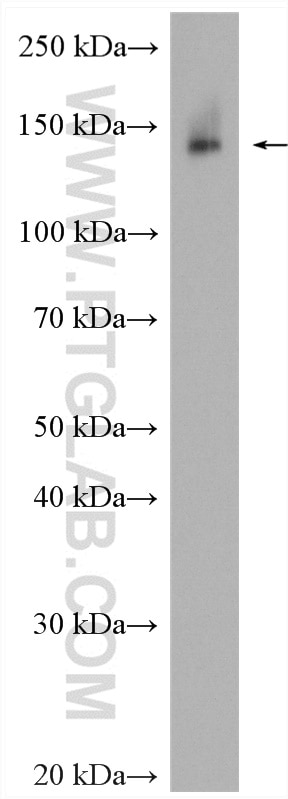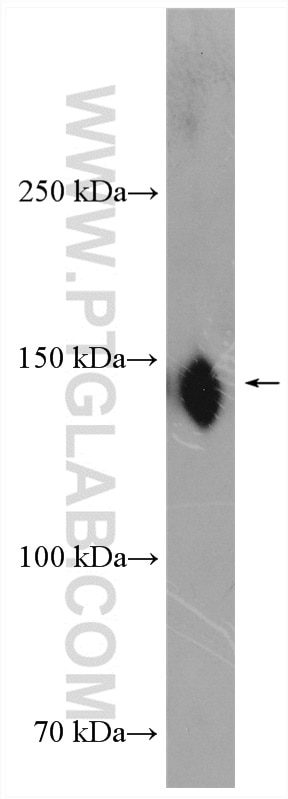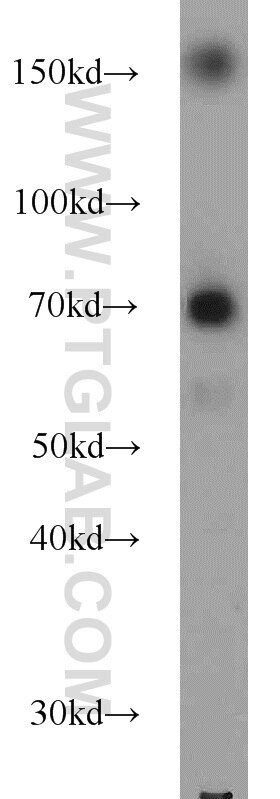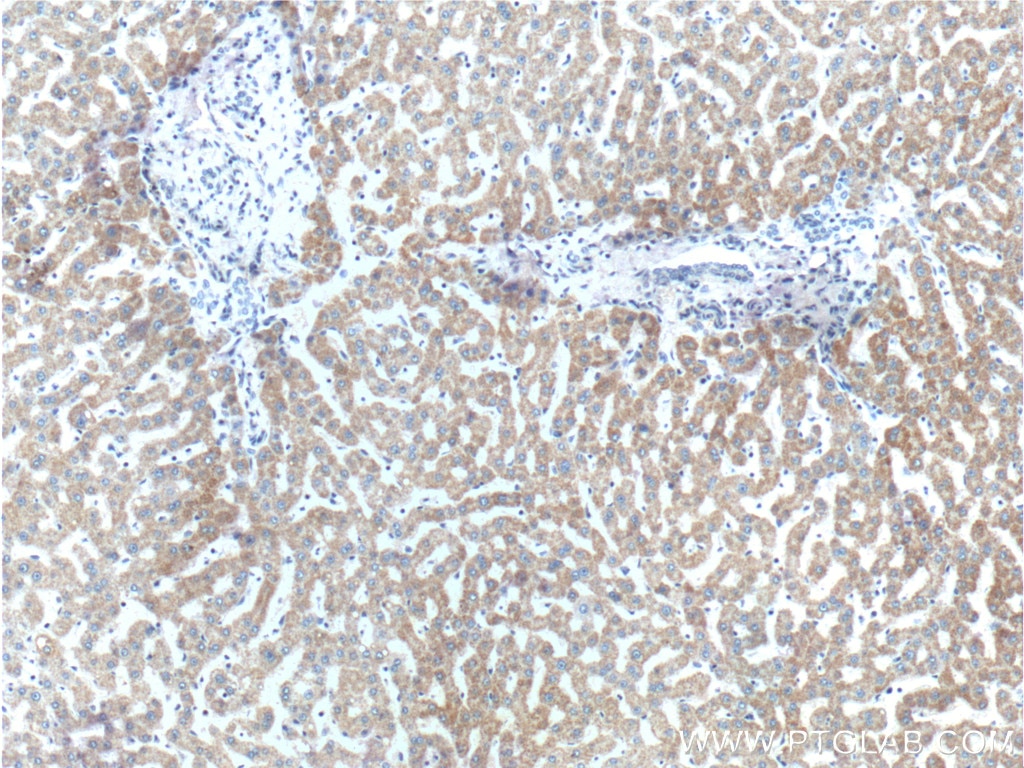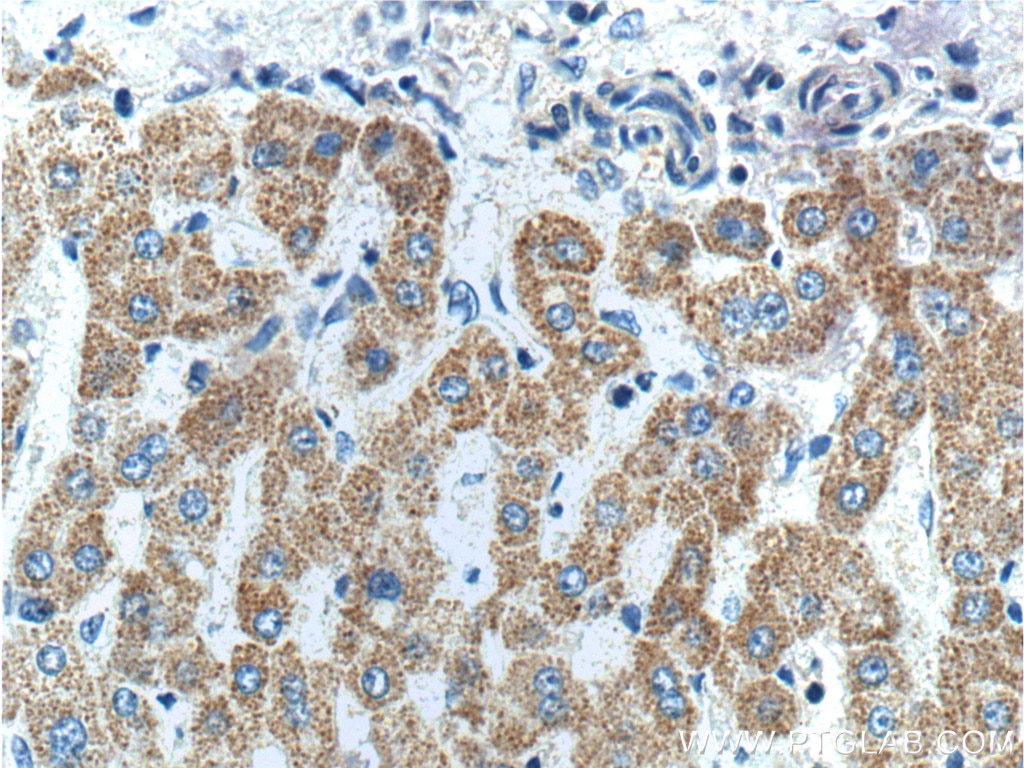Tested Applications
| Positive WB detected in | 4T1 cells, HL-60 cells, HepG2 cells, C6 cells |
| Positive IP detected in | HepG2 cells |
| Positive IHC detected in | human liver tissue Note: suggested antigen retrieval with TE buffer pH 9.0; (*) Alternatively, antigen retrieval may be performed with citrate buffer pH 6.0 |
Recommended dilution
| Application | Dilution |
|---|---|
| Western Blot (WB) | WB : 1:500-1:2000 |
| Immunoprecipitation (IP) | IP : 0.5-4.0 ug for 1.0-3.0 mg of total protein lysate |
| Immunohistochemistry (IHC) | IHC : 1:20-1:200 |
| It is recommended that this reagent should be titrated in each testing system to obtain optimal results. | |
| Sample-dependent, Check data in validation data gallery. | |
Published Applications
| KD/KO | See 2 publications below |
| WB | See 9 publications below |
| IHC | See 3 publications below |
| IF | See 1 publications below |
Product Information
22605-1-AP targets FNDC3B in WB, IHC, IF, IP, ELISA applications and shows reactivity with human, mouse, rat samples.
| Tested Reactivity | human, mouse, rat |
| Cited Reactivity | human, mouse |
| Host / Isotype | Rabbit / IgG |
| Class | Polyclonal |
| Type | Antibody |
| Immunogen |
CatNo: Ag18357 Product name: Recombinant human FNDC3B protein Source: e coli.-derived, PET28a Tag: 6*His Domain: 3-370 aa of BC039297 Sequence: VTMMMTDQIPLELPPLLNGEVAMMPHLVNGDAAQQVILVQVNPGETFTIRAEDGTLQCIQGPAEVPMMSPNGSIPPIHVPPGYISQVIEDSTGVRRVVVTPQSPECYPPSYPSAMSPTHHLPPYLTHHPHFIHNSHTAYYPPVTGPGDMPPQFFPQHHLPHTIYGEQEIIPFYGMSSYITREDQYSKPPHKKLKDRQIDRQNRLNSPPSSIYKSSCTTVYNGYGKGHSGGSGGGGSGSGPGIKKTERRARSSPKSNDSDLQEYELEVKRVQDILSGIEKPQVSNIQARAVVLSWAPPVGLSCGPHSGLSFPYSYEVALSDKGRDGKYKIIYSGEELECNLKDLRPATDYHVRVYAMYNSVKGSCSEPV Predict reactive species |
| Full Name | fibronectin type III domain containing 3B |
| Calculated Molecular Weight | 1204 aa, 133 kDa |
| Observed Molecular Weight | 150 kDa, 70 kDa |
| GenBank Accession Number | BC039297 |
| Gene Symbol | FNDC3B |
| Gene ID (NCBI) | 64778 |
| RRID | AB_2879133 |
| Conjugate | Unconjugated |
| Form | Liquid |
| Purification Method | Antigen affinity purification |
| UNIPROT ID | Q53EP0 |
| Storage Buffer | PBS with 0.02% sodium azide and 50% glycerol, pH 7.3. |
| Storage Conditions | Store at -20°C. Stable for one year after shipment. Aliquoting is unnecessary for -20oC storage. 20ul sizes contain 0.1% BSA. |
Background Information
Fibronectin type III domain-containing protein 3B(FNDC3B), also named FAD104, belongs to the FNDC3 family. NDC3B is a positive regulator of adipocyte differentiation and is expressed at an early stage of adipocyte differentiation. FNDC3B is an endoplasmic reticulum transmembrane protein with a single transmembrane domain at the C terminus preceded by nine repeated fibronectin type III domains(PMID: 32966780). Due to the ability of the fibronectin type III domain to bind to a variety of proteins, FNDC3B plays a crucial role in cell adhesion, proliferation, and growth signaling. FNDC3B is abnormally expressed in a variety of human cancers, including hepatocellular carcinoma, acute myeloid leukemia, colorectal carcinoma, and cervical carcinoma(PMID: 36275754).
Protocols
| Product Specific Protocols | |
|---|---|
| IHC protocol for FNDC3B antibody 22605-1-AP | Download protocol |
| IP protocol for FNDC3B antibody 22605-1-AP | Download protocol |
| WB protocol for FNDC3B antibody 22605-1-AP | Download protocol |
| Standard Protocols | |
|---|---|
| Click here to view our Standard Protocols |
Publications
| Species | Application | Title |
|---|---|---|
Cancer Sci FNDC3B 3'-UTR shortening escapes from microRNA-mediated gene repression and promotes nasopharyngeal carcinoma progression.
| ||
J Cell Physiol FNDC3B circular RNA promotes the migration and invasion of gastric cancer cells via the regulation of E-cadherin and CD44 expression. | ||
Am J Transl Res EYA1 promotes cell migration and tumor metastasis in hepatocellular carcinoma. | ||
J Cell Commun Signal CircRNA hsa_circ_0001627 aggravates cervical cancer progression through upregulation of FNDC3B and activating PI3K/mTOR signaling pathway |
